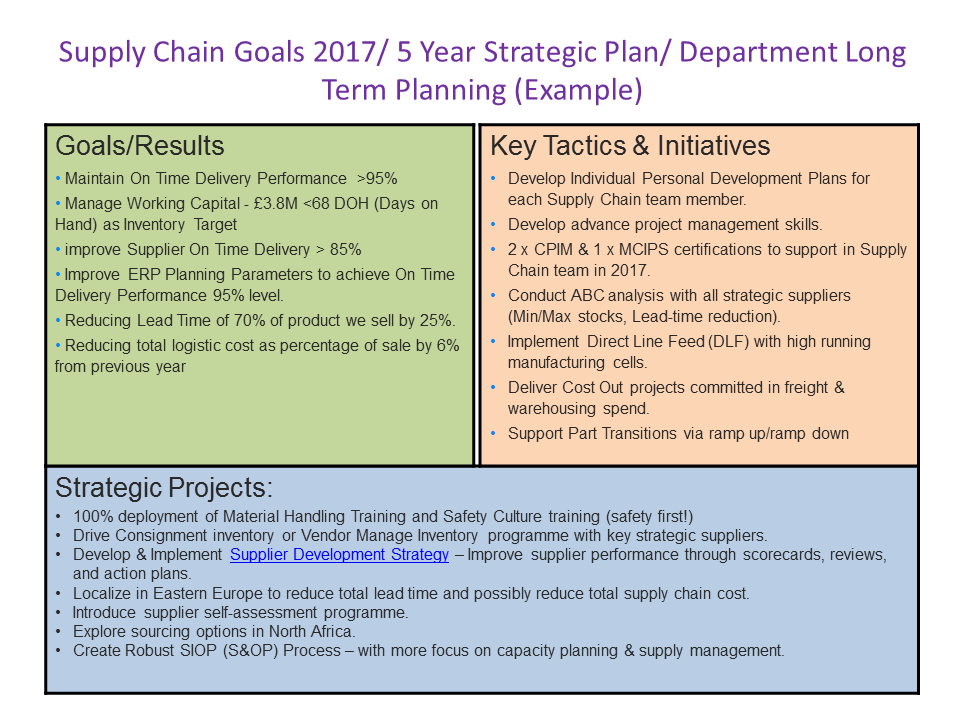2017 is about to start with new set of goals and challenges; it can be hard to know where you should first focus your efforts and what your supply chain strategic plan for coming year should be. After all, by now you’ve probably read so much about supply chain strategic plans that you’re left feeling overwhelmed and not sure of what needs to be done.
When you feel like this, it’s important to take a step back and create your plan. In this post, we’re going to take a look at how you can create a supply chain strategic plan for nearly any type of business, regardless of size, nature and industry.
We’ll examine how you can build a rock-solid supply chain strategic plan for the next year, from the ground up, what would be key elements of consideration and how you can adapt your plan, if changes need to be made.
By the end of this post, you should feel less overwhelmed and more confident about how to take your supply chain to the next level.
Understand Supply Chain Goals, Strategy and Tactics
When you’re creating an online marketing plan, it’s important that you understand the difference between goals, strategy and tactics. When you do, you’ll be better able to adapt your approach, when conducting a supply chain strategic plan.
On top of that, you’ll also be able to better judge how you can implement things that you learn from various articles that you may read in the future.
So, what’s the difference between goals, strategy and tactics?
A Goal is the overarching result that you’re looking to achieve. It’s often what you focus on first, as shown above. So a goal of yours might be to drive 95% On-Time Deliver performance, by doing daily root cause analysis for highest Pareto issues and committing to improvement actions.
Strategy is a set of decisions you want to make in a certain direction and is high-level thinking related to how you might achieve that goal. So, the strategy might be to get people through APICS or CIPS or SCMDOJO Academy training to develop supply chain competencies to give your business a competitive advantage.
Tactics are the specific set of actions that you take in order to achieve the strategy. So, tactics might include to start an inventory ABC analysis for inventory optimization or strategic pricing in 2017.
One of the best way to aligned and communicate Strategy, Goals and Tactics is deploying S&OP process so the same message is delivered at all levels of organization.
A lot of the supply chain content that you’ve probably read by now focuses on tactics, rather than goals and strategy or linkage of 3.
For example, a blog post, telling you how you’re going to get more throughputs out of your warehouse, doesn’t always include strategy, in terms of how it is linked to your overall business strategy and goals.
As a result, after reading such an article, you probably tried to apply the tactics mentioned in the blog to either Slot Most Ordered Products in Picking Areas or Narrow the Aisles or Take Advantage of Overhead Space but you didn’t see how increasing throughput would contribute to the larger picture of supply chain strategic plan.
When creating supply chain strategic plans, based on content that you have read, it’s important that you know how to link supply chain tactics with supply chain strategy and goals.
Okay, so now that we’ve cleared that up it is very important to under understand your customer needs and expectation known as Voice of Customer. As with all supply chain efforts, it is absolutely essential that you know who your end customer is.
Let’s take a look at how you can outline your goals, tactics and strategy. I can explain this by showing you how I do it. To start with I always keep 4 Pillars of Supply Chain Strategy in mind. And then I think about What Results & Goals I have to achieve next year, what my Key initiatives are and what are my key Strategic Projects which have a longer term (more than 12 months) impacts.
Studying competitors is important while thinking about Goals, Strategy and Tactics, because doing so lets you know what tactics are already working in your niche or markets and you might adopt/learn a thing or two.
Note: I am not talking about stealing anything that your competitors are doing. What I am talking about, though, is learning from those who have come before you.
Supply Chain Strategic Planning Process
Now it is time to explain the 3 Step process to define Supply Chain Goals/Results, Key Tactics/Initiatives and Strategy
Step 1: Define your key Supply Chain Goals & Results:
Looking at your business model and competitors, list down key goals and results you want to achieve. A typical example of goals could look like:
- Maintain On Time Delivery Performance >95%
- Manage Working Capital – £3.8M <68 DOH (Days on Hand) as Inventory Target
- Improve Supplier On Time Delivery > 85%
- Improve ERP Planning Parameters to achieve On Time Delivery Performance 95% level.
- Reducing Lead Time of 70% of product we sell by 25%.
- Reducing total logistic cost as percentage of sale by 6% from previous year.
Step 2: Define Key Tactics & Initiatives to Achieve Goals
Tactics in general could be a set of short terms initiatives you are taking to achieve your short term goals, which also contribute towards your long terms strategy. A typical example of initiative could look like:
- Develop Individual Personal Development Plans for each Supply Chain team member.
- Develop advance project management skills.
- SCMDOJO Academy certifications to support in Supply Chain team knowledge development
- Conduct ABC analysis with all strategic suppliers (Min/Max stocks, Lead-time reduction).
- Implement Direct Line Feed (DLF) with high running manufacturing cells.
- Deliver Cost Out projects committed in freight & warehousing spend.
- Deploy best practices in your supply chain.
Step 3: Outline Supply Chain Strategy
As Max McKeown (2011) defines, “strategy is about shaping the future and is the human attempt to get to desirable ends with available means”.
Most of us have read or heard of this strategy definition at some point in some variation. But what strikes me most in this definition is the “desirable ends with available means”. Whilst it is always great to be ambitious but what needs to be considered in achieving the strategy with available means.
The following is a typical example of what supply chain strategic themes may look like:
- 100% deployment of Material Handling Training and Safety Culture training (safety first!)
- Drive Consignment inventory or Vendor Manage Inventory programme with key strategic suppliers.
- Develop & Implement Supplier Development Strategy – Improve supplier performance through scorecards, reviews, and action plans.
- Localize in Eastern Europe to reduce total lead time and possibly reduce total supply chain cost.
- Introduce supplier self-assessment programme.
- Create Robust SIOP (S&OP) Process – with more focus on capacity planning & supply management.
- Explore sourcing options in North Africa.
Supply Chain Strategic Plan – how you can combine everything
Combining everything – decide on how your Supply Chain Strategic Plan is going to be effective?
Once you’re clear on your goals, who your customer are, the results you’re aim to achieve and how you will get them, you then need to decide how you’re going to make it happen. Sound obvious right! But is it that simple?!
To start with you can put the all three elements in one slide like below image and sit down as a team and agree on the short term and long term actions with owners, due dates and projected results. Pulsing these actions effectively and systematically takes lot of effort and focus – this in itself is a huge area to be covered in a different blog!
Note: When you’re working on this stage of your supply chain strategic plan, it also helps to decide on a figure that you’re willing to spend, in order to achieve your goal. Having that figure in mind will help make it easier to select the tactics that you can take advantage of.
Also above image is just an example, you need to create one suitable for your business and market.
See my talk at IPSM Conference 2019, Ukriane on ‘How to create a supply chain strategic plan’, which you will find it useful.
Conclusion
The foundation of nearly every successful supply chain effort comes down to a well-conceived plan.
It’s important to know the difference between tactics and strategy when you’re formulating your supply chain strategic plan – otherwise, you might just end up going round in circles.
It also helps to see what’s already working well in your industry, so that you can learn from those who have come before you.
Are there any tips you can share when it comes to creating a supply chain strategic plan? Please let me know in the comments below!
About the Author- Dr Muddassir Ahmed
Dr MuddassirAhmed is the Founder & CEO of SCMDOJO. He is a global speaker, vlogger and supply chain industry expert with 17 years of experience in the Manufacturing Industry in the UK, Europe, the Middle East and South East Asia in various Supply Chain leadership roles. Dr. Muddassir has received a PhD in Management Science from Lancaster University Management School. Muddassir is a Six Sigma black belt and founded the leading supply chain platform SCMDOJO to enable supply chain professionals and teams to thrive by providing best-in-class knowledge content, tools and access to experts.
You can follow him on LinkedIn, Facebook, Twitter or Instagram









